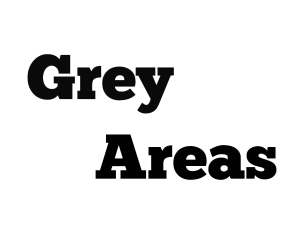 Grey Areas in Leading Ethically
Grey Areas in Leading Ethically
We see plenty of information about lying, cheating, stealing and other obvious ethical violations. It is more difficult to know what to do when we encounter behaviors that fall into ethical grey areas, particularly in term of relationships with other people.
How We Handle Grey Areas Paints a Border That Outlines Our Ethics
If we allow people to sabotage each other to win rewards, and withhold information from one another to appear more powerful, we are creating a culture that endorses negative interpersonal behaviors. If we “permit” sabotage and withholding information by not noticing and/or not addressing them, are we also endorsing more negative behaviors that people may see as similar, like bullying and employee harassment? We may be unintentionally sending the message that we allow even more negative behaviors in a broader context – are we also endorsing withholding information from customers and other important stakeholders? What about regulators? If we allow people to withhold information at one level, are we unintentionally saying that that behavior is okay anytime, at any level?
How we handle the grey areas in how people treat each other paints a border that becomes the outline of our company’s ethics.
Ignoring Negative Behaviors Allows Them to Flourish
When it comes to organizational culture, not knowing is not a defense. When we ignore negative interpersonal behaviors, we send a powerful message across the company to ‘do more of that’! If we use negative interpersonal behaviors or simply look the other way when we see negative behaviors, employees will too.
Negative behaviors that we choose to ignore don’t typically go away – they multiply when we fail to act because the behaviors are then assumed to be “accepted by leadership.” As leaders we need to walk around, to notice what’s going on, to create high-trust workplaces, to provide opportunities for meaningful communication, to ask people what’s getting in the way of their success, to talk about ethical behavior and to remove barriers to effective ethical performance.
People will follow our lead. When we ignore negative behaviors, we are supporting them.
Cases, Examples and Graphics About Grey Areas in Ethical Leadership
As leaders, we need to regularly discuss the grey areas in what it means to behave ethically. This lets us help employees define ethical behavior clearly and provide input into the choices they make to be sure that they meet the expectations of the company. As we learn more as a society about the impact of our choices and our behavior on others, there will continue to be more areas where employees will need guidance.
The most important thing is to ask employees about which ethical issues they would like to be talking about. Here are some posts to get you talking, followed by more articles for further reading
Case Study: Is Withholding Information From Other Leaders Unethical? Linda Fisher Thornton, Leading in Context® Blog
Case Study: Think Before You Blame (The Culture May Be The Cause) Linda Fisher Thornton, Leading in Context® Blog
Ethical Interpersonal Behavior Graphic (Three Zones of Behavior – Some Ethical, Some Not) Linda Fisher Thornton, Leading in Context® Blog
Related Research
Unethical and Unwell: Decrements in Well-Being and Unethical Activity at Work Giacalone and Promislo, Journal of Business Ethics
Creating and Sustaining an Ethical Workplace Culture Charles D. Kerns, PHD, MBA, Graziadio Business Review, Pepperdine University
7 Factors That Drastically Increase Workplace Violence Carol Fredrickson, Violence-free.com
 For more, see new book 7 Lenses and the 21 Question Assessment: How Current is My Message About Ethics?
For more, see new book 7 Lenses and the 21 Question Assessment: How Current is My Message About Ethics?
 2014 Axiom Business Book Award Winner
About 7 Lenses
Info@LeadinginContext.com @leadingincontxt @7Lenses
© 2011 Leading in Context LLC
2014 Axiom Business Book Award Winner
About 7 Lenses
Info@LeadinginContext.com @leadingincontxt @7Lenses
© 2011 Leading in Context LLC
http://twitter.com/#!/leadingincontxt/status/105006188319617025
I do agree that ignoring negative interpersonal behaviors or simply look the other way when we see negative behaviors. On the other hand, co-workers who speak up usually face retaliation. In offices with grey ethical behavior, most bosses are aware of the negative issues. Some managers make up excuses for the supervisor, or the supervisor has favoritism among the staffs. It’s a tough world out here. If you are not a favorite of the management team, you are in the dog house at work.
LikeLike
Thanks for your question! You might be interested in these articles that address the challenges in how we handle money and values:
https://leadingincontext.com/2011/01/12/traps-in-how-we-think-about-leading-the-case-of-focusing-too-much-on-budget/, https://leadingincontext.com/2017/09/20/the-missing-domain-ethical-thinking-part-2/, https://leadingincontext.com/2015/03/18/fix/, and https://leadingincontext.com/2015/02/11/why-people-lead/.
LikeLike
What are examples of ethucal gray area in financial management
LikeLike
Thanks Ian. I have not read it, but look forward to it. I can tell by the title that it will be a good read. Thanks for suggesting it!
LikeLike
Thanks Linda. Have you read Giving Voice to Values by Mary Gentile? I’m currently teaching Business Ethics at Grenoble Business School and I’ve found it a useful resource to close the gap between ethical reflection and ethical action. Based on what you said, I think you’ll find it a useful resource.
LikeLike
Very nice, i suggest webmaster can set up a forum, so that we can talk and communicate.
LikeLike